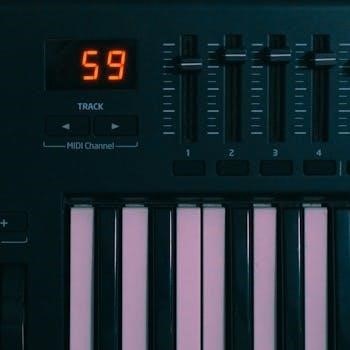Multiplying Mixed Numbers⁚ Worksheet PDFs
Enhance your math skills with multiplying mixed numbers! Our free printable worksheets are perfect for grade 5 and beyond․ Practice converting, multiplying, and simplifying with answer keys included․ Master mixed number multiplication today!
Multiplying mixed numbers might seem daunting, but it’s a fundamental skill in arithmetic with real-world applications․ Mixed numbers, combining whole numbers and fractions, appear frequently in measurements, recipes, and various practical scenarios․ Understanding how to multiply them accurately is essential for problem-solving in everyday life and for building a solid foundation in mathematics․

This guide aims to demystify the process of multiplying mixed numbers․ We’ll break down the steps into manageable segments, providing clear explanations and examples along the way․ From converting mixed numbers to improper fractions to simplifying the final results, each stage will be thoroughly covered․
Whether you’re a student looking to improve your math skills or a teacher seeking effective resources for your classroom, this material offers a comprehensive approach to mastering mixed number multiplication․ We’ll explore various techniques and strategies, ensuring a deep understanding of the underlying concepts․
By the end of this guide, you’ll be equipped with the knowledge and confidence to tackle any mixed number multiplication problem․ You’ll be able to apply these skills to solve real-world problems and advance your mathematical abilities․ So, let’s embark on this journey and unlock the secrets of multiplying mixed numbers together!
Remember, practice is key to mastering any mathematical concept․ We’ll provide ample opportunities for you to hone your skills through practice problems and printable worksheets․ With consistent effort and a clear understanding of the steps involved, you’ll become proficient in multiplying mixed numbers in no time․
Get ready to dive into the world of mixed numbers and discover the simple yet powerful techniques for multiplying them successfully․ Let’s begin!
Converting Mixed Numbers to Improper Fractions
Before you can multiply mixed numbers, it’s essential to convert them into improper fractions․ An improper fraction is a fraction where the numerator (the top number) is greater than or equal to the denominator (the bottom number)․ This conversion is a crucial step because it simplifies the multiplication process․
Here’s how to convert a mixed number to an improper fraction⁚
- Multiply the whole number by the denominator of the fraction․ This gives you the number of parts in the whole number portion of the mixed number․
- Add the numerator of the fraction to the result from step 1․ This gives you the total number of parts in the mixed number․
- Write the result from step 2 as the new numerator of the improper fraction․
- Keep the same denominator as the original fraction in the mixed number․
Let’s illustrate this with an example⁚ Convert 2 1/3 to an improper fraction․
- Multiply the whole number (2) by the denominator (3)⁚ 2 * 3 = 6
- Add the numerator (1) to the result⁚ 6 + 1 = 7
- Write 7 as the new numerator⁚ 7
- Keep the same denominator⁚ 3
Therefore, 2 1/3 is equal to the improper fraction 7/3․
This conversion process may seem tricky at first, but with practice, it becomes second nature․ Understanding why this conversion works is also important․ A mixed number represents a whole number plus a fraction․ By converting it to an improper fraction, you’re expressing the entire quantity as a single fraction, making multiplication straightforward․
Once you’ve mastered converting mixed numbers to improper fractions, you’ll be well-prepared to move on to the next step⁚ multiplying the improper fractions together․ This skill is fundamental for solving a wide range of math problems involving mixed numbers, so take the time to practice and perfect it․
Multiplying Improper Fractions
Now that you know how to convert mixed numbers to improper fractions, the next step is to understand how to multiply these improper fractions․ Multiplying improper fractions is actually quite simple and follows a straightforward rule⁚ multiply the numerators together to get the new numerator, and multiply the denominators together to get the new denominator․
Here’s the rule in mathematical terms⁚
If you have two improper fractions, a/b and c/d, then their product is (a * c) / (b * d)․
Let’s look at an example․ Suppose you want to multiply 7/3 by 5/2․
- Multiply the numerators⁚ 7 * 5 = 35
- Multiply the denominators⁚ 3 * 2 = 6
Therefore, 7/3 * 5/2 = 35/6․
It’s as simple as that! Once you’ve converted the mixed numbers to improper fractions, the multiplication process itself is very manageable․ This method works regardless of the size of the numbers involved․ Whether you’re multiplying small improper fractions or larger ones, the rule remains the same․
However, it’s important to remember that after multiplying, you may need to simplify the resulting fraction․ Simplifying involves reducing the fraction to its lowest terms by dividing both the numerator and the denominator by their greatest common factor (GCF)․ We’ll cover simplifying fractions in the next section․
Simplifying the Resulting Fraction
After multiplying improper fractions, the product you obtain isn’t always in its simplest form․ Simplifying fractions is a crucial step to ensure that your answer is presented in the most concise and understandable manner․ Simplifying a fraction means reducing it to its lowest terms, where the numerator and denominator have no common factors other than 1․
To simplify a fraction, you need to find the greatest common factor (GCF) of the numerator and the denominator․ The GCF is the largest number that divides evenly into both the numerator and the denominator․ Once you’ve found the GCF, you divide both the numerator and the denominator by it․
Here’s a step-by-step guide to simplifying fractions⁚
- Find the Greatest Common Factor (GCF)⁚ Determine the largest number that divides both the numerator and denominator without leaving a remainder․ There are several methods to find the GCF, including listing factors or using the Euclidean algorithm․
- Divide by the GCF⁚ Divide both the numerator and the denominator by the GCF․ This will reduce the fraction to its simplest form․
- Check for Further Simplification⁚ After dividing by the GCF, double-check that the new numerator and denominator have no other common factors․ If they do, repeat the process until the fraction is fully simplified․
Let’s illustrate this with an example․ Suppose you’ve multiplied two improper fractions and obtained the result 24/36․
- Find the GCF⁚ The factors of 24 are 1, 2, 3, 4, 6, 8, 12, and 24․ The factors of 36 are 1, 2, 3, 4, 6, 9, 12, 18, and 36․ The greatest common factor of 24 and 36 is 12․
- Divide by the GCF⁚ Divide both the numerator and the denominator by 12⁚
- 24 ÷ 12 = 2
- 36 ÷ 12 = 3
Therefore, the simplified fraction is 2/3․ This fraction is in its simplest form because 2 and 3 have no common factors other than 1․
Simplifying fractions not only makes the answer easier to understand but also helps in comparing fractions and performing further calculations․ Practice simplifying fractions regularly to become proficient in this essential skill․ Remember, the goal is to present the fraction in its most reduced form, making it easier to work with and interpret․

Mastering the skill of simplifying fractions ensures accuracy and efficiency in mathematical problem-solving․ By following these steps, you can confidently reduce any fraction to its simplest form, enhancing your overall understanding and competence in fraction manipulation․
Free Printable Worksheets for Practice
To truly master multiplying mixed numbers, consistent practice is key․ Fortunately, numerous free printable worksheets are available online to help you hone your skills․ These worksheets offer a variety of problems, ranging from simple multiplication of mixed numbers to more complex scenarios involving simplification and word problems․ Utilizing these resources can significantly improve your understanding and proficiency in working with mixed numbers․
These free printable worksheets are designed to cater to different skill levels, making them suitable for learners of all ages․ Whether you’re a student just starting to learn about mixed numbers or someone looking to brush up on your skills, you’ll find worksheets that meet your needs․ Many websites offer a range of worksheets, allowing you to progressively increase the difficulty as you become more confident․
Here are some types of practice you can expect to find in these worksheets⁚
- Basic Multiplication⁚ Worksheets focusing on multiplying two or more mixed numbers together․ These typically start with simpler problems and gradually increase in complexity․
- Simplification Practice⁚ Worksheets that require you to simplify the resulting fraction after multiplication․ This reinforces the importance of reducing fractions to their lowest terms․
- Mixed Practice⁚ Worksheets that combine multiplication with other operations such as addition, subtraction, and division․ These help you apply your skills in a more comprehensive context․
- Word Problems⁚ Worksheets that present real-world scenarios requiring you to multiply mixed numbers to find the solution․ These help you understand the practical applications of mixed number multiplication․
When using these worksheets, it’s helpful to follow a structured approach⁚
- Start with the Basics⁚ Begin with worksheets that focus on simple multiplication of mixed numbers․ Ensure you understand the process of converting mixed numbers to improper fractions and multiplying them․
- Progress Gradually⁚ As you become more comfortable, move on to worksheets that include simplification and mixed operations․ Challenge yourself with more complex problems․
- Tackle Word Problems⁚ Once you’ve mastered the basic skills, try word problems to apply your knowledge in real-world contexts․ This will help you develop problem-solving skills․
- Check Your Answers⁚ Always check your answers against the answer key provided․ Identify any mistakes and review the steps to understand where you went wrong․
- Practice Regularly⁚ Consistent practice is essential for mastering mixed number multiplication․ Set aside time each day or week to work on these worksheets․
By taking advantage of the free printable worksheets available, you can gain the practice you need to confidently multiply mixed numbers and excel in your math studies․ Remember to focus on understanding the underlying concepts and applying them consistently to different types of problems;
Word Problems Involving Mixed Number Multiplication
Word problems provide a practical application of mixed number multiplication, bridging the gap between abstract mathematical concepts and real-life scenarios․ These problems challenge students to identify the relevant information, set up the correct equation, and solve it accurately, reinforcing their understanding of mixed number multiplication in a meaningful context․ By working through word problems, learners develop critical thinking skills and learn to apply mathematical concepts to everyday situations․
These word problems often involve scenarios such as⁚
- Cooking and Baking⁚ Problems involving recipes that require multiplying mixed number quantities of ingredients․ For example, scaling a recipe up or down, or calculating the total amount of flour needed for multiple batches of cookies․
- Construction and Measurement⁚ Problems involving calculating the area of a rectangular garden, the length of fencing needed for a yard, or the amount of material required for a project․
- Travel and Distance⁚ Problems involving calculating distances traveled, speeds, or time taken, where mixed numbers represent fractions of hours or miles․
- Finance and Budgeting⁚ Problems involving calculating costs, discounts, or percentages, where mixed numbers represent portions of amounts or rates․
To successfully solve word problems involving mixed number multiplication, it is crucial to⁚
- Read Carefully⁚ Understand the context of the problem and identify what is being asked․
- Identify Key Information⁚ Extract the relevant numbers and units from the problem․
- Set Up the Equation⁚ Translate the word problem into a mathematical equation using mixed numbers․
- Convert to Improper Fractions⁚ Convert any mixed numbers to improper fractions to facilitate multiplication․
- Multiply⁚ Multiply the improper fractions to find the result․
- Simplify⁚ Simplify the resulting fraction to its lowest terms and convert back to a mixed number if necessary․
- Check Your Answer⁚ Ensure the answer makes sense in the context of the problem and that the units are correct․
Here’s an example of a word problem involving mixed number multiplication⁚

A baker needs to make 2 1/2 batches of cookies․ Each batch requires 1 3/4 cups of flour․ How many cups of flour does the baker need in total?
Solution⁚
- Identify Key Information⁚ 2 1/2 batches, 1 3/4 cups of flour per batch․
- Set Up the Equation⁚ 2 1/2 * 1 3/4
- Convert to Improper Fractions⁚ 5/2 * 7/4
- Multiply⁚ 35/8
- Simplify⁚ 4 3/8
- Check Your Answer⁚ The baker needs 4 3/8 cups of flour in total․
By practicing word problems, students gain a deeper understanding of how mixed number multiplication is used in real-world situations, improving their problem-solving skills and mathematical proficiency․

Answer Keys and Solutions
Comprehensive answer keys and detailed solutions are indispensable components of effective learning resources for multiplying mixed numbers․ These resources serve as valuable tools for students to self-assess their understanding, identify areas where they may need additional support, and reinforce the correct methods for solving problems․ The inclusion of step-by-step solutions provides a clear and concise pathway for students to follow, enabling them to understand the logic behind each step and replicate the process in future problems․
A well-structured answer key should include⁚
- Correct Answers⁚ Accurate and verifiable solutions to all problems presented in the worksheets․
- Step-by-Step Solutions⁚ Detailed explanations of each step involved in solving the problem, from converting mixed numbers to improper fractions to simplifying the final result․
- Clear and Concise Explanations⁚ Easy-to-understand explanations that break down complex concepts into manageable steps․
- Visual Aids (Optional)⁚ Diagrams or illustrations that help to visualize the problem and the solution process․
- Alternative Methods (Optional)⁚ Presentation of alternative methods for solving the problem, catering to different learning styles and preferences․
The benefits of using answer keys and solutions include⁚
- Self-Assessment⁚ Students can independently check their work and identify mistakes, promoting self-reliance and accountability․
- Error Analysis⁚ Students can analyze their errors to understand where they went wrong and learn from their mistakes․
- Reinforcement of Concepts⁚ Reviewing the solutions reinforces the correct methods and concepts, solidifying understanding․
- Independent Learning⁚ Answer keys and solutions facilitate independent learning, allowing students to work at their own pace and learn from their mistakes without relying solely on teacher assistance․
- Improved Problem-Solving Skills⁚ By studying the step-by-step solutions, students develop their problem-solving skills and learn to approach problems in a systematic and logical manner․
When using answer keys and solutions, it is important to encourage students to⁚
- Attempt the Problems First⁚ Encourage students to attempt to solve the problems on their own before referring to the answer key․
- Use the Answer Key for Verification⁚ Use the answer key to verify their answers and identify any mistakes․
- Study the Solutions Carefully⁚ Carefully study the step-by-step solutions to understand the correct methods and concepts․
- Identify and Analyze Errors⁚ Identify and analyze their errors to understand where they went wrong and learn from their mistakes․
- Practice Similar Problems⁚ Practice similar problems to reinforce their understanding and improve their problem-solving skills․
By providing comprehensive answer keys and detailed solutions, educators can empower students to take ownership of their learning and develop a deeper understanding of multiplying mixed numbers․ These resources not only provide the correct answers but also guide students through the problem-solving process, fostering a deeper understanding of the underlying concepts and improving their mathematical proficiency․
